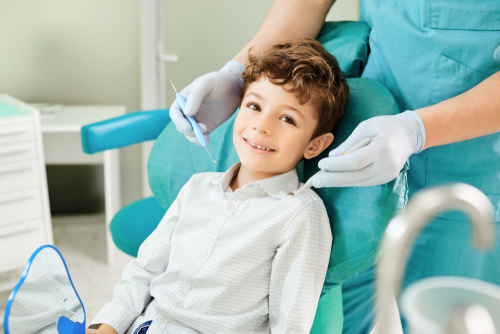Childhood is a series of firsts—first steps, first words, first tastes of the things we instantly love but our teeth don’t. Sticky caramels, fizzy sodas, birthday cake piled high with frosting—tiny indulgences that feel harmless at the moment. Meanwhile, those first teeth are doing more than just helping us chew. They’re setting the stage for the smile we’ll carry into adulthood. But just like every new experience requires guidance—learning to walk, tying shoelaces, reading a book—so does taking care of our teeth. That’s where another important first comes in: the first dental visit. More than a quick checkup, Taking your children to the dentist is an introduction to lifelong habits.
A child who learns early that the dentist’s chair isn’t a place to fear is far more likely to maintain routine care into adulthood. And when that visit happens on time, it can prevent small issues from turning into bigger problems. So, when should that first visit happen? What will it involve? How do you prepare a child for something they’ve never experienced before? We’re here to guide you through it all—answering questions, easing concerns, and making sure your child’s first dental visit is a positive one. Because setting the right foundation now means fewer worries later—and a lifetime of healthier smiles.
Dentist for Children: When Should the First Visit Happen?
Your child should see the dentist by their first birthday—or within six months after their first tooth comes in, whichever happens first. This early visit might seem premature, but it sets the tone for a lifetime of healthy smiles.
Baby teeth might be temporary, but they serve some important jobs. They help your child speak clearly, chew properly, and hold space for permanent teeth. Even before all their teeth are in, decay can sneak in—especially if sugary drinks or nighttime bottles are in the picture. We can spot early signs of trouble before they become worse. By establishing a “dental home,” your child has a trusted place to turn for all things oral health. It’s not just about checkups. It’s about having a dentist who understands your child’s development, offers guidance as they grow, and steps in quickly if something goes wrong—like a fall or a toothache.
The first dental visit is also a great chance for parents to ask questions. We will show you how to brush those tiny teeth, offer nutrition tips that protect enamel, and help you understand what’s normal regarding teething, thumb-sucking, or pacifier use. Children who visit the dentist early also tend to feel more comfortable during appointments as they age. The unfamiliar becomes familiar.
Visiting a Dentist for Children: What to Expect
When you bring your child in for their first visit, we focus on making the experience smooth, positive, and reassuring—for both of you. We start by creating a relaxed, welcoming environment. Instead of jumping straight into an exam, we take a few moments to connect with your child and help them feel at ease. It’s important to us that they feel safe and comfortable from the very beginning.
Once your child is settled, we gently examine their mouth. We look at the gums, any baby teeth that have come in, and other soft tissues like the tongue and cheeks. This early evaluation helps us check for normal development and spot any early signs of concern—such as decay, gum irritation, or bite alignment issues.
If needed, we’ll do a gentle cleaning to remove any plaque buildup. For some children, especially if several teeth have come in, we may also recommend a fluoride varnish. This quick, painless treatment helps strengthen enamel and offers added protection against cavities.
We spend time with you, too—answering questions and offering tips tailored to your child’s needs. Whether you’re wondering how to brush tiny teeth, relieve teething discomfort, or manage thumb-sucking habits, we’ll give you practical, caring advice. We also discuss healthy eating habits and the best ways to support your child’s oral health at home.
How To Maintain Oral Health in Between Visits
Unlike adults, children don’t yet understand the long-term benefits of good oral hygiene. That’s why we focus on turning daily care into something they enjoy and want to participate in.
Kids learn best through play, repetition, and example. When you introduce flossing as soon as two teeth touch, you’re not just removing plaque—you’re setting a routine early, one that feels normal and expected. Since most kids won’t have the coordination to floss effectively on their own for a few years, your hands-on help ensures their teeth stay clean while they build the skill.
Food choices matter, too. We encourage a balanced diet not just for growing bodies but for healthy teeth and gums. Reducing sugary snacks and acidic drinks helps protect enamel, while calcium-rich foods support strong development. Crunchy fruits and vegetables do double duty—they offer nutrition and naturally scrub away debris during chewing. When kids enjoy healthy foods, it becomes easier to keep their smiles strong without constant reminders.
We also know that motivation looks different for kids. Letting them choose their own toothbrush and toothpaste gives them a sense of ownership. A brush with a favorite character or toothpaste in a fun flavor can make all the difference in how willing they are to brush.
Make the First Visit Count: Book Your Appointment Now
Your child’s first dental visit is more than a milestone. It is a moment that shapes how they care for their smile for years to come. With the right guidance, a gentle approach, and a little creativity at home, you can help your child build healthy habits they’ll carry well into adulthood. We’re here to support you every step of the way—from that very first appointment to every visit that follows. Schedule your child’s first dental visit with us today!

